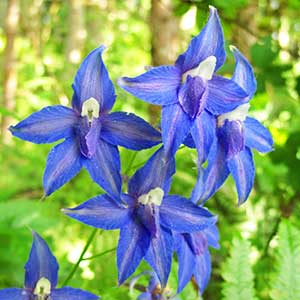Delphinium trolliifolium
Delphinium decorum
Columbian larkspur, cow-poison, poison delphinium, poison larkspur
coast larkspur, coastal larkspur, larkspur, low larkspur, yellowtinge larkspur
(40-)60-120(-180) cm;
base usually reddish, glabrous to puberulent.
5-25(-42) cm;
base reddish or not, at least two proximal internodes long-pubescent.
blade ± pentagonal, 4-8 × 7-16 cm, margins ± incised, nearly glabrous; ultimate lobes 0-9, width 15-30 mm (basal), 5-20 mm (cauline), widest at middle or in proximal 1/2.
blade deltate to pentagonal, 1-2.5 × 1.5-4.5 cm, ± puberulent; ultimate lobes 3-15, width 3-17 mm (basal), 1-8 mm (cauline), widest at middle or in proximal 1/2.
(5-)14-40(-75)-flowered, ± open, at least 2 times longer than wide;
pedicel 1-4(-9) cm, puberulent to glabrous;
bracteoles (2-)6-12 mm from flowers, green, linear, 5-9(-14) mm, puberulent.
2-10(-20)-flowered;
pedicel 1-4(-6) cm, puberulent to glabrous;
bracteoles (3-)7-11(-21) mm from flowers, green to blue, linear-lanceolate, 6-9(-12) mm, puberulent.
sepals dark blue, glabrous, lateral sepals spreading, (8-)14-21 × 5-9 mm, spurs straight or downcurved at apex, within 20° of horizontal, (10-)16-23 mm;
lower petal blades covering stamens, 5-10 mm, clefts 1.5-3 mm;
hairs sparse, mostly near junction of blade and claw, centered or on inner lobes, well dispersed, yellow.
sepals bluish purple (somewhat faded on drying), puberulent, lateral sepals spreading, (11-)15-20(-24) × 6-11(-15) mm, spur straight, 0-30° above horizontal, 13-20 mm;
lower petal blades ± covering stamens, 6-11 mm, cleft 2-4 mm;
hairs on entire surface, densest on inner lobes, yellow or white.
(15-)23-34 mm, 3.8-5.5 times longer than wide, glabrous.
9-20 mm, 3-4.5 times longer than wide, glabrous to puberulent.
unwinged;
seed coats smooth.
wing-margined;
seed coat cells ± aggregate in small wavy ridges, cell surfaces ± roughened, without swollen, blunt hairs.
= 16.
Delphinium trolliifolium
Delphinium decorum
Delphinium trolliifolium occurs in the northern Coast Range of California, the Columbia River Valley to just east of Mt. Hood, and the Willamette Valley of Oregon upstream to Lane County. California plants differ somewhat from Oregon plants in pubescence patterns and habitat preferences. Further study may show that two entities are involved here.
Hybrids between Delphinium trolliifolium and D. decorum, D. menziesii subsp. pallidum (D. ×pavonaceum Ewan, Peacock larkspur), D. nudicaule, D. nuttallianum, and D. nuttallii are known. Delphinium trolliifolium is likely to be confused only with D. bakeri. Refer to discussion under that species for differences.
(Discussion copyrighted by Flora of North America; reprinted with permission.)
Subspecies 2 (2 in the flora).
Delphinium decorum and D. menziesii have been confused. Delphinium menziesii usually has darker, colorfast (nonfading) sepals with less lavender, and a more northern distribution than D. decorum. It also has more finely dissected leaves than D. decorum subsp. decorum.
Often confused with Delphinium patens, D. decorum is sometimes circumscribed to include that species. The spreading, fading, blue-purple sepals, pubescent proximal portion of stems, and large lower petal blade of D. decorum, compared to the reflexed, colorfast, bluer sepals, proximally glabrous stems, and smaller lower petal blades of D. patens, adequately distinguish the two taxa.
(Discussion copyrighted by Flora of North America; reprinted with permission.)
1. Leaf blade usually with 3–5 lobes longer than 1/2 leaf radius; 0–100 m. | subsp. decorum |
1. Leaf blade usually with more than 5 lobes longer than 1/2 leaf radius; 700–2300 m. | subsp. tracyi |


